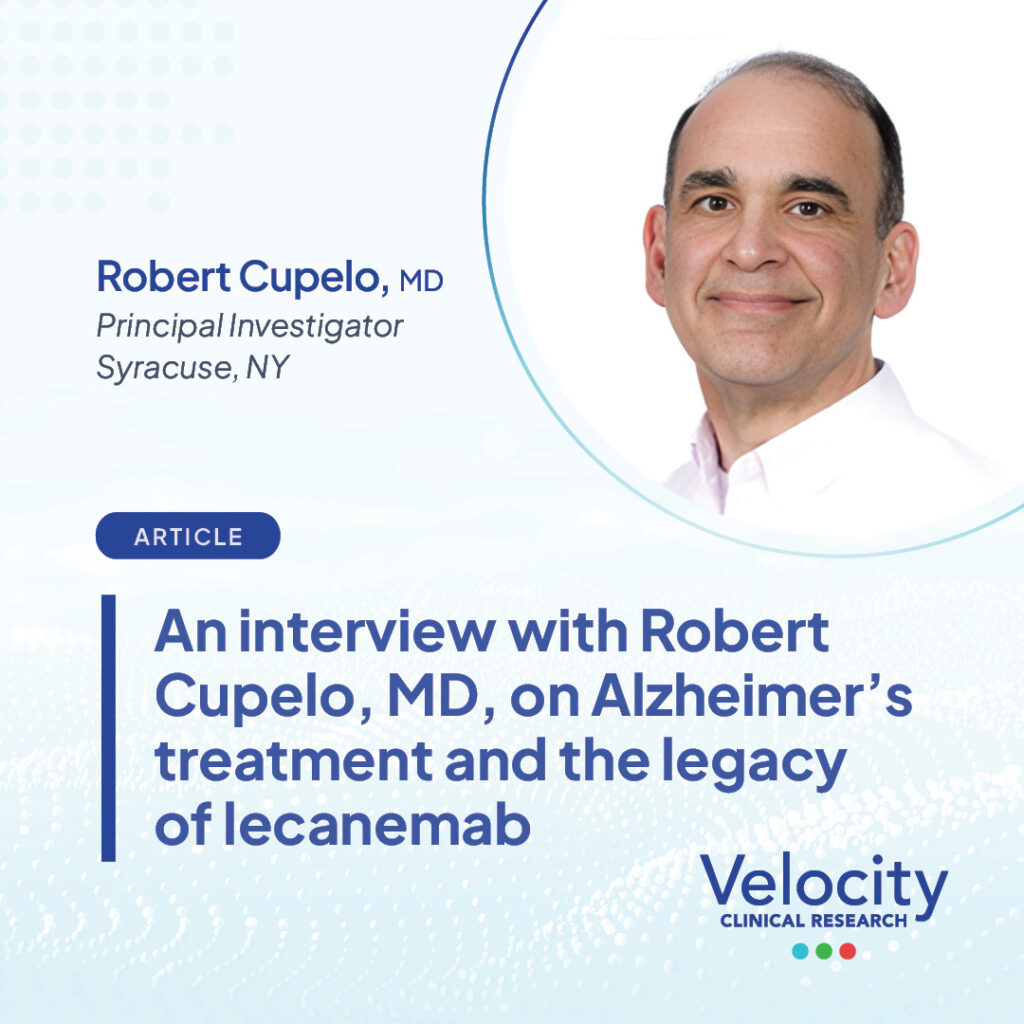It’s been just over a year since the monoclonal antibody Lecanemab received traditional approval from the FDA as a treatment for Alzheimer’s disease. This marked a turning point in the disease’s treatment, a drug that interrupted progression for the first time rather than simply addressing the symptoms.
It was this type of breakthrough that Robert Cupelo, MD hoped for when he joined Velocity’s Syracuse site as Principal Investigator in 2017. Before that, he’d spent 36 years in primary care, treating patients skewed toward the age group most at risk of Alzheimer’s, and it was this experience that, in part, encouraged him to cross over into clinical research. “It was heartbreaking giving that diagnosis in practice,” he recalls, joining our video call early morning from a brightly lit meeting room at the clinic, “And all you can offer is a drug that doesn’t do much.”
If you ever have to receive that kind of bad news, you want it delivered by someone like Dr. Cupelo. Instantly disarming, he seems utterly unflappable, endlessly knowledgeable, and overwhelmingly kind — even across a Zoom connection. Ostensibly, we’re there to discuss the legacy of Lecanemab one year after its approval, but he deftly steers the conversation to encompass a far broader scope.
A novel approach to Alzheimer’s treatment
Lecanemab’s approval a year ago was a turning point, the first switch from treating the symptoms of Alzheimer’s to interrupting the disease. But the drug is not without its faults. Not least are the logistics and costs involved in delivering biweekly infusions, as well as some potentially prohibitive side effects, among them the chance of a brain bleed.
Dr. Cupelo points out that the introduction of Lecanemab changed the conversation for physicians. Previously, they could put patients on Donepezil (Aricept) with the expectation that it could only help and that it might give a family a chance at an extra few months with their loved ones. The side effects of Lecanemab are more dangerous, meaning the cost-benefit analysis for patients and their physicians is very different.
“When you take a step back and look at Lecanemab, it’s doing the same thing [as Aricept],” Dr. Cupelo explains, “It buys three to five months before that person needs more care.”
An extra few months with a loved one isn’t a gift Dr. Cupelo would ever dismiss or devalue. He speaks with great warmth of his father-in-law, one of the last independent small pharmacists in Fulton, New York, who succumbed to the disease. One of the family’s favorite memories is a picture of ‘Papa’ with his eldest great-grandson on one of the much-loved patriarch’s last good days. “We have pictures of that day everywhere, and if we could add more pictures, we would,” he says.
Papa was part of the reason Dr. Cupelo chose to delay his retirement to work in clinical trials at a site specializing in Alzheimer’s research. He notes that the hope Lecanemab provides to patients and their families is its most notable impact: “That might be the biggest success of the whole thing.”
The importance of clinical trials
That hope is a motivator for many clinical trial participants. While achieving a few extra months or an unlikely cure might encourage some Alzheimer’s sufferers to sign up for trials, Dr. Cupelo doesn’t believe that’s a core motivator — many want to contribute to a better outcome for patients in the future.
He’s quick to note that developments like Lecanemab wouldn’t be possible without clinical trial participants, “Nothing happens nowadays without clinical research. It’s involved in our lives much more than people realize. If you took a pill today, that was backed by research.”
Dr. Cupelo also points out that we’re still learning all the risk factors that contribute to Alzheimer’s. The presence of amyloid proteins has been known since the disease was named, and the initial thinking was that their build-up caused it. “But now we know it’s not just that,” explains Dr. Cupelo. “We understand the tau protein, that some people have inflammation in the brain or a genetic predisposition. So we’re learning about all the different things that have to happen to make someone have Alzheimer’s. And the more we learn, the more possibilities that creates for treatment.”
Treating Alzheimer’s with a combination
While monoclonal antibody treatments tend to capture the headlines, Dr. Cupelo explains that other promising treatments are emerging to attack Alzheimer’s in different ways. Ultimately, he believes the future of successful Alzheimer’s treatment — not just management but prevention — will be a cocktail.
“Just like leukemia and AIDS, the treatment for Alzheimer’s is going to be a combination, a cocktail,” he muses. “Maybe one drug to get rid of the amyloid, plus an anti-inflammatory, or one of these medicines that block the enzyme so you can’t make the amyloid anymore. That’s the way we conquered AIDS, combinations that support each other.”
But that requires the tools to build a regime. “Before you get down to making a cocktail, you have to develop things that work,” explains Dr. Cupelo. That’s why Lecanemab, as the first disease-modifying treatment, is such a fundamental advancement.
The case for prevention
One of Dr. Cupelo’s key frustrations in the trial environment is that he only sees patients aged over 50. Yet, risk factors such as an extensive family history of the disease or genetic markers are known long before patients hit that age. “If everybody in your family had a heart attack, we have no issues putting you on a statin at 30 years old. We can’t do that for Alzheimer’s yet,” he says.
Dr. Cupelo and his team are currently participating in a study of Donanemab, which was approved by the FDA for the early treatment of symptomatic Alzheimer’s at the beginning of July. This study is preclinical; participants are normal cognitively but have some abnormalities on their PET scans or genetic markers that put them at higher risk. “We’re part of one arm of one study that’s following these people to see if they develop it,” Dr. Cupelo explains, “But that’s going to take a really long time.”
Donanemab was approved under the brand name Kisunla. Like Lecanemab, it aims to interrupt disease progression and is the first amyloid plaque-targeting therapy. Treatment can be halted once amyloid plaques are removed; which helps to keep costs down. Initial studies showed that Donanemab can significantly slow down clinical decline, particularly among patients who were less advanced in the disease. “The things with all these medicines like Donanemab, the earlier people take it, the better it works,” affirms Dr. Cupelo.
Dr. Cupelo is just one champion of many seeking to advance early detection and prevention of Alzheimer’s. In March of this year, Congress announced a $100m increase in funding for Alzheimer’s and dementia research, which has bipartisan support. The Bill includes $34 million to “strengthen public health infrastructure… implementing effective Alzheimer’s interventions focused on … early detection and diagnosis, reducing risk and supporting caregivers.”
The legacy of Lecanemab
Lecanemab was a fundamental step forward in the treatment of Alzheimer’s, and it has sparked a wave of innovation and development, including the licensing of a second disease-modifying treatment, Donanemab, almost exactly a year later.
Dr. Cupelo is confident that this momentum, aided by research funding from both the public and private sectors, will lead to further breakthroughs in the treatment and early detection of Alzheimer’s. His hope is a solution that gives more families more last good days and the opportunity to add a few more pictures to the mantlepiece.

